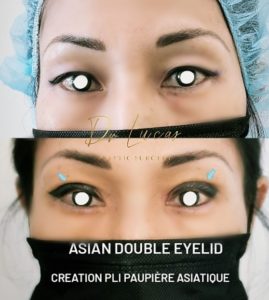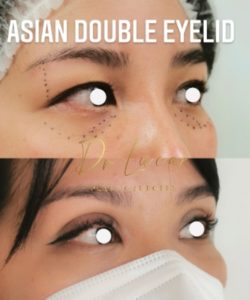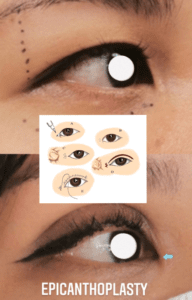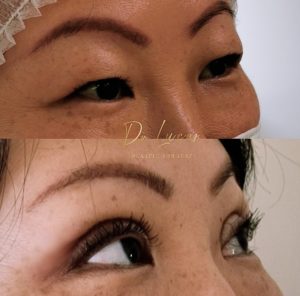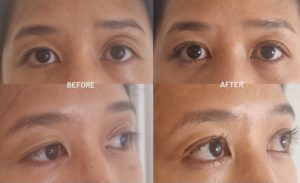Ideal anatomy and proportions :
The aging mechanism of the Asian eye is roughly similar to that of the Caucasian eye, but the basic anatomy of the eye structures is very different.
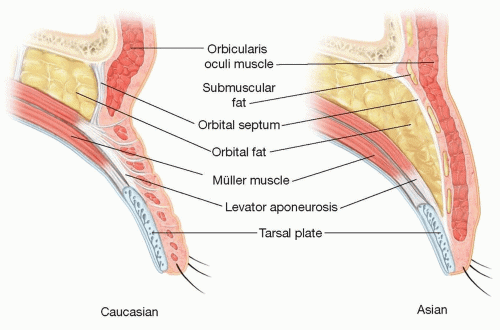
Anatomy comparison of the eyelids between Asians and Europeans
The upper eyelid fold is absent in about 80% of Koreans and Chinese, while it is absent on average in 30% of Japanese and South Asians (Thailand, Cambodia, Vietnam, …). Often, when it is present, it is too low (2-4 mm from the ciliary margin instead of 5-8 mm). This is due to 3 factors specific to the anatomy of the Asian eyelid: there is less connection between the fascia of the eyelid elevator muscle and the skin, often its insertion as well as the insertion of the septum is lower in Asians and there is more often an excess of fat even in young patients under the septum, thus creating a bulging appearance of the eyelid.
Approximately 70% of Asians have an epicanthus, which covers the inner corner of the eye giving a hard and severe look to the eyes and closing the eye, it can be corrected in the same surgical time.

A young Asian eye is defined by an eyebrow in an ideal position (1 cm higher than the orbital rim), a deep and well-defined upper crease not coming into contact with the lashes (distance crease to lashes: 6-8 mm, different from Caucasians), a smooth lower eyelid without hollows or bulging.
Technique of asian blepharoplasty:
Regarding upper eyelid surgery, it is a more complex surgery than in Caucasians, with a very different technique and anatomy. It consists of excising the excess fat, exposing the levator fascia muscle (which has the main role of opening the eyelid) and suturing the lower part of the scar to the levator muscle of the eyelid. Thus, when the eye is opened, the scar will be pulled by the levator muscle and a well defined fold will be formed.
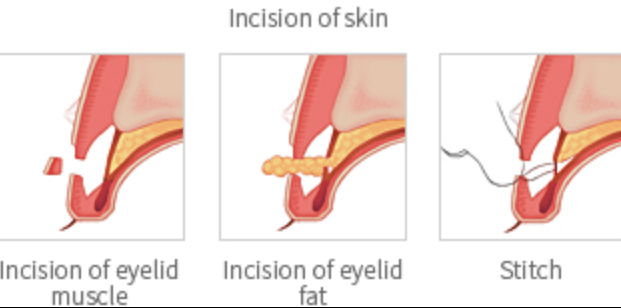
Technique to create an upper fold
An epicanthoplasty procedure can be performed during the same operation.
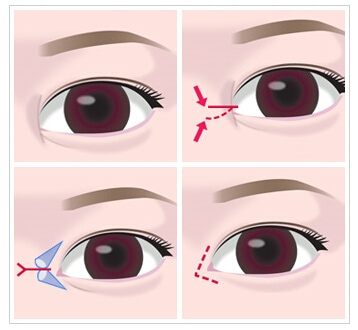
Epicanthoplasty
Lower eyelid surgery is different for Caucasians because there is rarely excess skin and tone abnormalities in Asians. Often, the excess of fat lodges must be corrected through a subconjunctival approach (inner, behind the lashes).
Scars :
The upper scar is located in the natural crease of the eyelid which is almost invisible 10 days after the procedure and the lower scar is internal, hidden behind the eyelashes.
Results :
Final results : After a 10 day social eviction, 50-70% of the results can be seen, after 3 weeks 80% of the results then to see the final result you have to wait about 2 months.
Longevity results: about 7 to 10 years, depending on each patient because we move back the time but do not stop it.
Before surgery:
Stop smoking at least 1 month before surgery
Do not take Aspirin 10 days before surgery, inform Dr. Lucas of any anticoagulant medication (Sintrom, Coumadin, Eliquis, etc..) to organize their discontinuation or replacement.
Take Arnica capsules 5 times a day for 5 days before surgery for patients prone to hematoma.
Intervention :
Pain: the pain during the intervention will be almost non-existent, with an adapted anesthesia
Duration of procedure: 1 hour
Anesthesia: local
Location: operating room
Ambulatory (without hospitalization)
After the operation:
Post-operative pain: 1/10 often responding to Dafalgan
Social eviction: 7 days for upper blepharoplasty, 7 to 10 for lower blepharoplasty
Suture removal: 5 days for upper blepharoplasty, 8 days for lower blepharoplasty
Return to work: 1 week
Return to sports: 10 days
Instructions :
Rest in bed without major effort (which can cause the opening of small vessels during effort and lead to a hematoma) for 48 hours
Ice mask for 1 week, as often as possible, to reduce swelling
Check-up by Dr Lucas on D2, D5, D8, 3 weeks, 3 months, 1 year
Do not wet the scar at the risk of detaching the steristrips until the sutures are removed, shower possible as soon as the sutures are removed
Vitamin A and artificial tears in the eye for 10 days
Massage of scars 2 times 5 minutes a day for 3 months with Gorgonium
Resume Aspirin 5 days after surgery after validation by Dr Lucas
Take Arnica capsules 5 times a day for 5 days after surgery to prevent hematoma
Sunglasses to protect the eyes, which will have an increased sensitivity to light, for 1 month.
Complications after an asian blepharoplasty
As far as the surgical procedure is concerned, by choosing a FMH Plastic Surgeon, trained in this type of procedure, you limit these risks as much as possible, without however eliminating them completely.
Real complications are rare following a blepharoplasty performed according to the rules. In practice, the vast majority of procedures are carried out without any problems and patients are satisfied.
– Hematomas: most of the time they are not serious, but they must be evacuated if they are too important.
– Infection: exceptional during a blepharoplasty, except for a few rare micro-abscesses that develop on a stitch and are easily treated with local care. A simple conjunctivitis will be prevented by the usual prescription of eye drops during the first days.
– Scarring abnormalities: very rare in the eyelids where the skin is very thin and usually heals almost invisibly, it may happen that the scars are not as discreet as hoped.
– Epidermal cysts: they can appear along the scars and often eliminate spontaneously. Otherwise, they are easy to remove during a follow-up consultation and do not compromise the quality of the final result.
– Disorders of tear secretion: persistent lacrimation is rarer than a “dry eye syndrome” which sometimes decompensates a pre-existing tear deficit.
– Ptosis (difficulty in opening the upper eyelid completely): rare, due to iatrogenic damage to the levator muscle of the eyelid.
– Lagophthalmos (inability to close the upper eyelid completely): possible in the first few days following the operation, its persistence beyond a few weeks should not be encountered.
– Asymmetry: rare, but any surgery can cause asymmetry
Alternatives and operations that can be combined:
Surgery of the upper and lower eyelids can be performed at the same time, in order to have a single, common social avoidance period.
When the lower eyelid presents a minimal excess of bags and a rather hollow appearance, the correction can be done by lipofilling fat transfer which allows not only to fill in but also to improve the coloring of the dark circles.
Global rejuvenation of the eye: blepharoplasty can be combined with a brow lift or a filling of the temples which are sometimes hollow.
